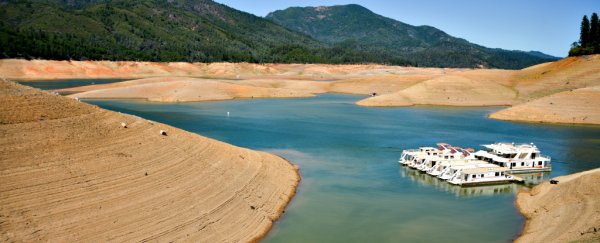Researchers have just found a huge reservoir of groundwater below California - making the supply of water below the state three times larger than previously estimated.
The new reserve won't solve the state's crippling drought, but the discovery suggests that more freshwater might be hiding in deep aquifers around the world than we think, and we need to figure out how to protect it.
"It's not often that you find a 'water windfall', but we just did," said one of the researchers, Robert Jackson, from Stanford University. "There's far more fresh water and usable water than we expected."
Last year, it was estimated that California lost 63 trillion gallons (238 trillion litres) of water over the course of 18 months of drought.
And up until now, it was thought that California's Central Valley had less than 1,000 km3 of water below it, because engineers had only assessed the groundwater within 1,000 feet (300 metres) of the surface - the previous limit on what we could tap into.
But the Stanford team have now analysed data from more 34,000 oil and gas wells in California, and estimated water volume all the way down to 10,000 feet (3,00 metres), and calculated that the reservoir actually contains 2,700 km3 - almost triple initial estimates.
While that sounds like incredible news for the state, the reason the water was so hard to find the first time is it's incredibly deep - most of it was estimated to lie between 1,000 and 3,000 feet (300 and 900 metres) below the surface.
Thanks to new technology, engineers are able to extract water from those depths, but the pumping will be expensive, and some of the deepest water might be salty, so would need to be treated before use.
Harvesting the liquid could also compromise the stability of the land above - in Central Valley, the researchers report that some of the land has already begun to noticeably sink as much as tens of feet, thanks to overuse of groundwater. And the last thing we need is more sinkholes.
Even worse, the newly found groundwater is already at risk of contamination from oil and gas extraction - around 30 percent of the supplies that the team found run are close to drilling sites.
But despite the challenges of the new water supply, the researchers say the main reason it won't help today's drought is that we're going to need to preserve it for the future, when water shortages are predicted to get even more extreme.
"We need to be careful about using it," Jackson told Ria Misra over at Gizmodo. "California's groundwater pumping has been in overdraft for years, especially during the drought. Finding more water than expected doesn't mean we should waste it."
The real benefit of the discovery is the fact that it sheds some light on the fact that these deep aquifers exist, and suggests that we might be able to find similar last resorts of water below other drought-prone regions, such as Australia and Africa.
The team hopes that the research will prompt more research into these resources, and hopefully better protection of them.
"What we are saying is that no one is monitoring deep aquifers. No one's following them through time to see how and if the water quality is changing," said one of the researchers, Mary Kang. "We might need to use this water in a decade, so it's definitely worth protecting."
The research has been published in the Proceedings of the National Academy of Sciences.
